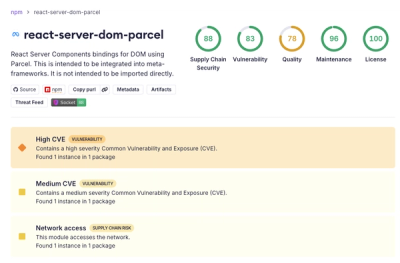
Security News
Deno 2.6 + Socket: Supply Chain Defense In Your CLI
Deno 2.6 introduces deno audit with a new --socket flag that plugs directly into Socket to bring supply chain security checks into the Deno CLI.
aotpy
Advanced tools
Helper Python package for handling Adaptive Optics Telemetry (AOT) standard files. For more information, please check the published specification for AOT. Basic package documentation available.
Support is offered for Python 3.10 or later.
python -m pip install aotpy
Clone the repository and then install with:
python -m pip install path/to/aotpy
where 'path/to/aotpy' is the path to the root of the cloned repository.
Here we exemplify of how to create an AOT FITS file from scratch. In general terms, we create an AOSystem object, fill the relevant data fields and then write that object into a FITS file which follows the AOT specification.
import numpy as np
import aotpy
# Create the system object and its main telescope
system = aotpy.AOSystem(ao_mode='GLAO')
system.main_telescope = aotpy.MainTelescope("Example telescope")
# Create the DM, which is installed on the main telescope.
dm = aotpy.DeformableMirror("Example DM", n_valid_actuators=32, telescope=system.main_telescope)
system.wavefront_correctors.append(dm)
# Create the sources being sensed.
ngs = aotpy.NaturalGuideStar("Example NGS")
lgs = aotpy.SodiumLaserGuideStar("Example LGS")
system.sources = [ngs, lgs]
# Create a 4 subaperture Shack-Hartmann WFS sensing the NGS source. It contains 10000 frames of slopes.
ngs_wfs = aotpy.ShackHartmann("WFS1", source=ngs, n_valid_subapertures=4,
measurements=aotpy.Image("NGS slopes", data=np.ones((10000, 2, 4))))
# Also create a detector for this WFS, containing 100 frames of pixel data (20x20).
ngs_wfs.detector = aotpy.Detector("DET1", pixel_intensities=aotpy.Image("Pixels", data=np.random.random((100, 20, 20))))
# Create a 8 subaperture Shack-Hartmann WFS sensing the LGS source. It contains 10000 frames of slopes.
lgs_wfs = aotpy.ShackHartmann("WFS2", source=lgs, n_valid_subapertures=8,
measurements=aotpy.Image("LGS slopes", data=np.ones((10000, 2, 8))))
system.wavefront_sensors = [ngs_wfs, lgs_wfs]
# Create the loops in the system.
# Both loops command the DM, but one handles LO modes using the NGS, while the other handles HO modes using the LGS.
lo_loop = aotpy.ControlLoop("LO loop", input_sensor=ngs_wfs, commanded_corrector=dm,
commands=aotpy.Image("LO commands", data=np.ones((10000, 32))),
control_matrix=aotpy.Image('LO control matrix', data=np.ones((32, 2, 4))))
ho_loop = aotpy.ControlLoop("HO loop", input_sensor=lgs_wfs, commanded_corrector=dm,
commands=aotpy.Image("HO commands", data=np.ones((10000, 32))),
control_matrix=aotpy.Image('HO control matrix', data=np.ones((32, 2, 8))))
system.loops = [lo_loop, ho_loop]
# Write the system to an AOT file. This file can then be read, recovering the exact same system.
system.write_to_file("example.fits")
In this example we assume we already have an AOT file. We can easily read it and explore its data. For demonstration purposes, we assume matplotlib is installed, although it is not a requirement for this package.
import matplotlib.pyplot as plt
import aotpy
# If we open the file that was created in the example above, the resulting "system" object will contain the exact same
# data as the "system" object that was built in the example above.
system = aotpy.AOSystem.read_from_file("example.fits")
# We can then display a frame of pixel data. For the data above, we know the first WFS has pixel data.
pixel_data = system.wavefront_sensors[0].detector.pixel_intensities.data
# Then we display the first frame of data.
plt.imshow(pixel_data[0])
plt.show()
This project has received funding from the European Union’s Horizon 2020 research and innovation programme under grant agreement No. 101004719 (OPTICON–RadioNet Pilot).
FAQs
Helper package for handling Adaptive Optics Telemetry (AOT) standard files
We found that aotpy demonstrated a healthy version release cadence and project activity because the last version was released less than a year ago. It has 1 open source maintainer collaborating on the project.
Did you know?

Socket for GitHub automatically highlights issues in each pull request and monitors the health of all your open source dependencies. Discover the contents of your packages and block harmful activity before you install or update your dependencies.

Security News
Deno 2.6 introduces deno audit with a new --socket flag that plugs directly into Socket to bring supply chain security checks into the Deno CLI.

Security News
New DoS and source code exposure bugs in React Server Components and Next.js: what’s affected and how to update safely.

Security News
Socket CEO Feross Aboukhadijeh joins Software Engineering Daily to discuss modern software supply chain attacks and rising AI-driven security risks.